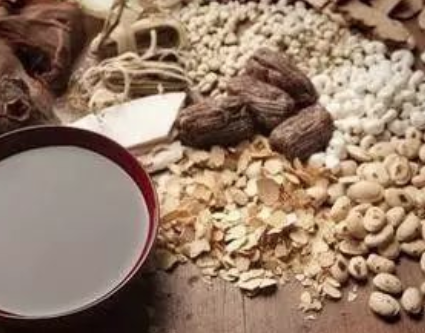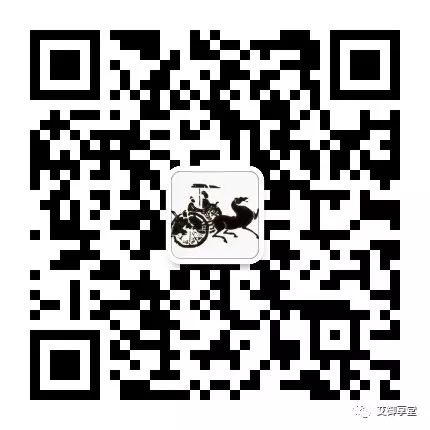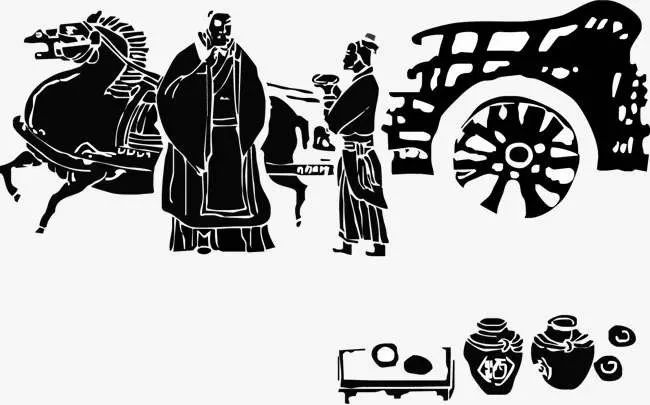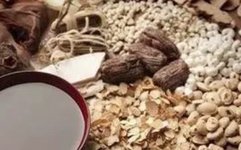Inheriting the legacy of Qi Huang, a public account with substance and warmth
Ai Yu Xiang Tang
Introduction:The formulas for treating mixed cold and heat in the Treatise on Cold Damage include Chai Hu Gui Zhi Gan Jiang Tang (Bupleurum and Cinnamon Decoction with Dried Ginger), Zhi Zi Gan Jiang Tang (Gardenia and Dried Ginger Decoction), Ban Xia Xie Xin Tang (Pinellia Decoction to Drain the Heart), Fu Zi Xie Xin Tang (Aconite Decoction to Drain the Heart), Huang Lian Tang (Coptis Decoction), Wu Mei Wan (Mume Pill), Ma Huang Sheng Ma Tang (Ephedra and Cimicifuga Decoction), and Gan Jiang Huang Qin Huang Lian Ren Shen Tang (Dried Ginger, Scutellaria, Coptis, and Ginseng Decoction), totaling eight formulas.

Chai Hu Gui Zhi Gan Jiang Tang has been discussed previously, while Zhi Zi Gan Jiang Tang will be briefly mentioned. Sheng Jiang Xie Xin Tang (Fresh Ginger Decoction to Drain the Heart) and Gan Cao Xie Xin Tang (Licorice Decoction to Drain the Heart) can be represented by Ban Xia Xie Xin Tang. Below is a brief description of each formula.Ban Xia Xie Xin TangBan Xia Xie Xin Tang is a formula that combines cold and hot herbs. It is a representative formula for harmonizing the cold and heat evils of the spleen and stomach. Sheng Jiang Xie Xin Tang and Gan Cao Xie Xin Tang are modifications based on it. It treats a syndrome characterized by disharmony of the spleen and stomach qi, with fullness and distension below the heart accompanied by phlegm and fluid.Due to the presence of phlegm and fluid, it also includes symptoms of vomiting. Clinical observations indicate that this syndrome may present with fullness below the heart, vomiting, borborygmus, diarrhea, or irregular bowel movements. The occurrence of this syndrome is due to the disharmony of yin and yang in the spleen and stomach, disordered ascending and descending, and the obstruction of qi in the middle jiao, leading to the generation of phlegm and fluid. Therefore, Ban Xia Xie Xin Tang is used to bitterly descend, pungently open, harmonize the stomach, and clear phlegm as its main actions.Ban Xia Xie Xin Tang consists of Ban Xia (Pinellia), Huang Qin (Scutellaria), Huang Lian (Coptis), Ren Shen (Ginseng), Zhi Gan Cao (Honey-fried Licorice), and Da Zao (Jujube). This syndrome involves poor ascending and descending of qi, obstruction in the middle jiao, and heat generated due to the stomach qi not descending. Therefore, the bitter cold properties of Huang Qin and Huang Lian are used to descend it, while the pungent warmth of Gan Jiang (Dried Ginger) is used to warm it, as the coldness of the spleen qi leads to borborygmus and diarrhea. Thus, Ban Xia is used to descend the rebellious qi and harmonize the stomach to stop vomiting.The weakness of the spleen and stomach qi cannot regulate the ascending and descending, hence Ren Shen, Gan Cao, and Da Zao are used to tonify it. This formula clears the upper and warms the lower, combining bitter descending and pungent opening, using both cold and heat to harmonize the spleen and stomach, making it the main formula for treating fullness below the heart.【Note】The area below the heart is a half-exterior, half-interior location (below the chest and above the abdomen), so when there is a disease, it is appropriate to use Xie Xin Tang to harmonize. However, Xiao Chai Hu Tang (Minor Bupleurum Decoction) treats the liver and gallbladder, while Xie Xin Tang treats the spleen and stomach. Both syndromes share the characteristic of poor ascending and descending of qi, and both are caused by the disharmony of yin and yang. If not treated with harmonization but with other methods, the disease cannot be cured.Especially since the “below the heart” area is the key pathway for the ascending and descending of qi, if the communication of yin and yang is obstructed, it leads to fullness. Fullness is a blockage, where qi stagnates and does not flow, neither blood nor water, and is not solid, hence pressing it feels moist, but it is merely qi fullness.Zhang, male, 36 years old. Has a history of alcohol consumption, presents with fullness below the heart, occasional vomiting, and unformed stools, three to four times a day, with various treatments yielding no effect. Pulse is wiry and slippery, tongue coating is white.Diagnosis: The syndrome is due to alcohol harming the spleen and stomach, with disordered ascending and descending, and phlegm generated internally. Phlegm and fluid cause the stomach qi to rebel, leading to vomiting, while spleen deficiency and cold qi lead to unformed stools, and disharmony of middle qi results in fullness below the heart.Prescription: Ban Xia 12g, Gan Jiang 6g, Huang Qin 6g, Huang Lian 6g, Dang Shen 9g, Zhi Gan Cao 9g, Da Zao seven pieces.After taking one dose, the stools expelled a large amount of white, sticky phlegm, and vomiting decreased significantly; after another dose, both fullness and vomiting reduced, and after taking two more doses, the illness was cured.Fu Zi Xie Xin TangFu Zi Xie Xin Tang is used to treat heat fullness below the heart, with yang deficiency unable to protect the exterior, accompanied by symptoms of “aversion to cold and sweating.” Generally, fever easily leads to sweating, while aversion to cold does not easily lead to sweating. However, when aversion to cold is accompanied by sweating, it reflects insufficient wei yang and loss of warming function.Wei yang refers to the yang qi that protects the exterior, originating from the lower jiao, transformed from the kidney’s yang qi, reaching the body surface, thus “warming the flesh, filling the skin, nourishing the pores, and controlling opening and closing.” If the lower jiao yang is deficient, it leads to insufficient transformation of wei yang, losing its warming and protective function, resulting in aversion to cold and sweating, hence termed as upper heat and lower cold syndrome. The treatment uses Fu Zi Xie Xin Tang to clear heat fullness and warm yang qi.Fu Zi Xie Xin Tang consists of Da Huang (Rhubarb), Huang Lian (Coptis), Huang Qin (Scutellaria), and Pao Fu Zi (Processed Aconite). The formula uses boiling water to soak Da Huang, Huang Lian, and Huang Qin to treat the heat fullness in the qi level, while Fu Zi is specially decocted in water to extract its strong flavor and power to specifically tonify the deficiency of kidney yang. Although this formula uses both cold and heat, the soaking of the three yellow herbs and the special decoction of Fu Zi emphasizes the support of yang while clearing heat.Ning Xiang, a student, had an external pathogen for several months and was repeatedly treated without improvement. Upon examination, he reported fullness in the chest, heat in the upper body with sweating, and aversion to wind below the waist, during the summer in June, while being wrapped up. Reviewing the previous prescriptions, they were all common clearing and draining remedies that did not address the root cause. The tongue coating was light yellow, and the pulse was wiry.With Fu Zi Xie Xin Tang, after two days of follow-up, he reported that the symptoms had significantly improved. He was discharged after a successful treatment. (Quoted from “Dun Yuan: Medical Cases”)Huang Lian TangHuang Lian Tang syndrome belongs to the pathological changes of “cold damage with heat in the chest and evil qi in the stomach.” Heat in the chest leads to vomiting, while evil qi in the stomach leads to abdominal pain or diarrhea. The treatment with Huang Lian Tang uses both cold and warmth, with sweet and bitter properties to regulate the yin and yang of the upper and lower, harmonizing the evil.Huang Lian Tang consists of Huang Lian (Coptis), Zhi Gan Cao (Honey-fried Licorice), Gan Jiang (Dried Ginger), Gui Zhi (Cinnamon), Ren Shen (Ginseng), Ban Xia (Pinellia), and Da Zao (Jujube). The formula uses Huang Lian to clear heat in the chest, Gan Jiang to warm the cold of the spleen and stomach, Gui Zhi to promote the yang qi of the upper and lower, Ban Xia to descend the rebellious qi and stop vomiting, and Ren Shen, Gan Cao, and Da Zao to nourish the stomach and calm the center, facilitating the regulation of the upper and lower, and harmonizing the cold and heat of yin and yang.Xuzhou Li, who suffered from vomiting and diarrhea, with three to four bowel movements a day, experiencing urgency and heaviness in the abdomen, with red and white sticky mucus. The illness persisted for a year, and after seeking treatment in various places without improvement, he came to Beijing at the recommendation of a friend for diagnosis. The pulse was wiry and slippery, with no strength upon palpation, and the tongue was red with a white coating.Diagnosis: This is a syndrome of mixed cold and heat evil, affecting the upper and lower spleen and stomach. If only one aspect is treated, either cold is treated with heat or heat with cold, it will not be effective. When cold and heat are both present, the method of Huang Lian Tang should be emulated.Prescription: Huang Lian 9g, Gan Jiang 9g, Gui Zhi 9g, Ban Xia 9g, Ren Shen 6g, Zhi Gan Cao 6g, Da Zao seven pieces. After taking six doses, the year-long illness was cured.Wu Mei WanWu Mei Wan is the main formula for treating the Jue Yin disease. When the disease reaches Jue Yin, the yin and yang mutually retreat, characterized by mixed cold and heat symptoms such as “thirst, qi rising to the heart, heat in the heart, and hunger without desire to eat.” Due to the mixed cold and heat, with upper heat and lower cold, it may present as vomiting of roundworms and coldness in the hands and feet, termed “roundworm syndrome,” all of which can be treated with Wu Mei Wan.Wu Mei Wan consists of Wu Mei (Mume), Xi Xin (Asarum), Gan Jiang (Dried Ginger), Huang Lian (Coptis), Fu Zi (Aconite), Dang Gui (Angelica), Shu Jiao (Sichuan Pepper), Gui Zhi (Cinnamon), Ren Shen (Ginseng), and Huang Bai (Phellodendron). This formula is the main one for treating the mixed cold and heat of Jue Yin and roundworm syndrome. The use of Wu Mei soaked in vinegar benefits the yin and harmonizes the yang, with effects of harmonizing the liver, calming the stomach, restraining yin, and stopping thirst. Fu Zi, Gan Jiang, and Gui Zhi warm the meridians and support yang to overcome cold.Chuan Jiao and Xi Xin are spicy and warm, capable of promoting yang and breaking yin, and can kill roundworms. Huang Lian and Huang Bai are bitter and cold, clearing heat and vexation, and subduing roundworms while treating vomiting. Ren Shen tonifies qi to strengthen the spleen, and Dang Gui nourishes blood to support the liver. The combination of these herbs expels cold and heat evils, harmonizes yin and yang, softens the liver, warms the lungs, and restrains roundworms, which is the essence of the formula.Although the formula uses both cold and heat, it is predominantly warm, and the sourness of Wu Mei helps to restrain and solidify, thus treating prolonged diarrhea due to mixed cold and heat. The use of rice and honey as auxiliary materials to make pills not only nourishes the stomach qi deficiency but also serves as bait to lure roundworms.Gansu Shangzhai, Zhou, female, 36 years old. Suddenly experienced paroxysmal severe pain in the upper right abdomen, cold limbs, profuse cold sweat, and vomiting. She had a history of roundworms. Examination revealed “worm spots” on the face, wiry and strong pulse, and a crimson tongue with dark coating. Diagnosed as roundworm syndrome of Jue Yin disease. The formula was modified from Wu Mei Wan to a decoction, taken in three doses. After two doses, the pain ceased, and she felt at ease.However, due to severe bitterness in the mouth, there was still vomiting, and she reported not having a bowel movement for several days. The treatment was switched to Da Chai Hu Tang (Major Bupleurum Decoction) for one dose, which resulted in the expulsion of many roundworms along with stools, leading to recovery.Ma Huang Sheng Ma TangMa Huang Sheng Ma Tang treats the syndrome of exterior evil trapped internally, with obstructed qi, upper heat and lower cold, and disharmony of yin and yang. Due to the internal trapping of yang evil, the originally floating pulse changes to a deep and slow one. The pulse at the lower part of the wrist is not present, indicating that the qi is obstructed, and the pulse pathway is not smooth.When the qi is obstructed, the yin and yang qi do not connect smoothly, leading to coldness in the hands and feet. If the internal trapped yang evil lingers above, it causes upper heat, resulting in throat discomfort and vomiting of pus and blood. The yang is trapped above and cannot govern below, leading to continuous diarrhea.This syndrome involves both yin and yang being affected, and the distinctions between deficiency and excess, cold and heat are also blurred, making it difficult to treat. However, Zhong Jing proposed Ma Huang Sheng Ma Tang to treat both cold and heat, expelling the trapped yang evil externally while nourishing the yin of the lungs and stomach, clearing the upper and warming the lower, ensuring the harmony of yin and yang for recovery.Ma Huang Sheng Ma Tang consists of Ma Huang (Ephedra), Sheng Ma (Cimicifuga), Dang Gui (Angelica), Zhi Mu (Anemarrhena), Huang Qin (Scutellaria), Wei Rui (Ophiopogon), Shao Yao (Peony), Tian Dong (Asparagus), Gui Zhi (Cinnamon), Fu Ling (Poria), Zhi Gan Cao (Honey-fried Licorice), Shi Gao (Gypsum), Bai Zhu (Atractylodes), and Gan Jiang (Dried Ginger). The formula uses a larger dose of Ma Huang and Sheng Ma to expel the trapped yang evil, while Huang Qin and Shi Gao clear the heat from the lungs and stomach. Gui Zhi and Gan Jiang promote yang and warm the middle to dispel cold, while Dang Gui and Shao Yao nourish blood to harmonize yin.Zhi Mu, Tian Dong, and Wei Rui nourish yin and lower fire to harmonize yang; Gan Cao, Fu Ling, and Bai Zhu not only strengthen the spleen and benefit qi to stop diarrhea but also calm the stomach and harmonize the center to facilitate the connection of the upper and lower. This formula combines tonifying and draining herbs to create a harmonious treatment for mixed cold and heat syndromes, with precise significance.Li Mengru’s child had two previous episodes of throat disease and one episode of diarrhea, all treated successfully. Now, he suffers from a cold and heat disease that has persisted for over ten days. I was invited to diagnose. Upon pulse examination, he had already had diarrhea twice, with headache, abdominal pain, and joint pain, and the throat was completely white and rotten, with purulent phlegm mixed with blood. The six pulses were floating, and both middle pulses were absent, with a weak pulse upon deep palpation, making it impossible to determine the exact number. He was thirsty and needed water, with little urination, and the pulse of the lesser yin was faint.After the diagnosis, I could not immediately prescribe a formula, as the reasoning was unclear. I considered various formulas such as Pus Expelling Decoction, Huang Lian Ejiao Decoction, and Bitter Wine Decoction, but none felt appropriate. I then proposed Gan Jiang Huang Qin Huang Lian Ren Shen Tang, but still felt it was not suitable. I modified it to Xiao Chai Hu Tang (Minor Bupleurum Decoction) for stability. However, due to rain, I stayed near Li’s residence, pondering and unable to sleep, and inquired with Li’s father: How many times has the patient sweated?He replied: There has been no sweating at all. Has he taken any laxatives? He said: He has taken purgatives three times, leading to frequent watery diarrhea, and the pulse suddenly changed to deep. I said: I understand now. This is the syndrome of Ma Huang Sheng Ma Tang. The patient’s pulse is weak and easily disturbed, with a history of throat disease, indicating a constitution of lower deficiency and upper heat. The new onset of Tai Yang cold damage, combined with excessive purging, has not resolved the exterior evil, leading to internal heat and triggering the old throat disease, hence the white rot and mixed pus and blood in the throat.The spleen is weak and damp, and due to excessive purging, it has led to watery diarrhea, with water flowing to the large intestine, hence the little urination. The upper jiao is hot, leading to thirst; the exterior evil has not resolved, hence the symptoms of cold and heat headache and joint pain persist; being trapped internally, the limbs are cold; after excessive purging, qi and blood gather internally, leading to a weak yang pulse; and the fluids tend to the lower part, hence the yin pulse is also closed off.This formula includes Gui Zhi Tang (Cinnamon Decoction) with Ma Huang added, thus releasing the exterior and inducing sweating. It also includes Fu Ling, Bai Zhu, and Gan Jiang to transform water and benefit urination, thus stopping diarrhea; using Dang Gui to assist in blood circulation and pulse connection, and Huang Qin, Zhi Mu, and Shi Gao to reduce inflammation and clear heat, while also generating fluids; using Sheng Ma to relieve throat toxicity, and Yu Zhu (Wei Rui) to expel pus and blood, and Tian Dong to clear phlegm and pus.Tomorrow, this formula can be taken as prescribed. Li was still concerned about the possibility of adverse reactions, fearing that the warmth of Ma Huang and Gui Zhi would be too much, wanting to add Ren Shen. I said: The weak and cold pulse indicates yang stagnation, not yang deficiency. Adding Ren Shen would hinder the expulsion of inflammation and detoxification, so it is better not to add it. The classic formula should not be altered. He eventually recovered. (Quoted from “Chen Xun Zhai Medical Cases”)Gan Jiang Huang Qin Huang Lian Ren Shen TangGan Jiang Huang Qin Huang Lian Ren Shen Tang is used to treat the syndrome of upper heat and lower cold, characterized by “vomiting immediately after eating” and severe diarrhea. Therefore, this formula clears the upper and warms the lower, treating both cold and heat.Gan Jiang Huang Qin Huang Lian Ren Shen Tang consists of Gan Jiang (Dried Ginger), Huang Qin (Scutellaria), Huang Lian (Coptis), and Ren Shen (Ginseng). The formula uses Huang Qin and Huang Lian to drain the upper heat, while Gan Jiang warms the spleen to dispel cold, and Ren Shen strengthens the spleen to tonify deficiency. This formula employs both cold and heat, with bitter descending and pungent opening, and Gan Jiang can also guide Huang Qin and Huang Lian, preventing the heat evil from causing obstruction. Therefore, some commentators believe this formula also treats “fire counterflow” vomiting.Yu, male, 29 years old. During the hot summer, he indulged in cold foods, leading to alternating vomiting and diarrhea, with vomiting more than diarrhea. He also experienced irritability and bitterness in the mouth. The pulse was rapid and slippery, and the tongue coating was yellow yet moist.Diagnosis: This is heat in the upper and cold dampness in the lower, and with the alternating vomiting and diarrhea, how can the stomach qi not be harmed? This is a syndrome of middle deficiency with mixed cold and heat.Prescription: Huang Qin 6g, Huang Lian 6g, Ren Shen 6g, Gan Jiang 3g, and instructed to add fresh ginger juice to the decoction. One dose was sufficient to stop vomiting and cure the illness.The mixed cold and heat formulas in the Treatise on Cold Damage represent a significant innovation in the study of formulas by Zhang Zhongjing. Their scientific value is very high, and we should inherit and promote them well. The seven formulas discussed above, while all serve to harmonize yin and yang and resolve the evils of cold and heat, each have their own characteristics.For example, Ban Xia Xie Xin Tang harmonizes yin and yang but is effective in treating fullness; Gan Jiang, Huang Qin, Huang Lian, and Ren Shen Tang harmonize yin and yang but are effective in treating vomiting; Wu Mei Wan harmonizes yin and yang but is effective in treating roundworms; Ma Huang Sheng Ma Tang harmonizes yin and yang but is effective in inducing sweating; and Fu Zi Xie Xin Tang harmonizes yin and yang but is effective in supporting yang and stopping sweating. These all reflect the characteristic of TCM to treat according to the syndrome.☆Text from “Liu Du Zhou Medical Books: Fourteen Lectures on the Treatise on Cold Damage” published by the People’s Health Publishing House, Author/Liu Du ZhouThis is for clinical reference only; non-professional doctors should not attempt acupuncture or medication. ID:hnbfdycx
ID:hnbfdycx

Ai Yu Xiang Tang
Copyright Statement:Edited by/Physician Dan, Proofread by/Feng Tu/Source from publicly available online materialsCopyright belongs to the original author
If you find it helpful, please like or read on!

